Potřebujeme váš souhlas k využití jednotlivých dat, aby se vám mimo jiné mohly ukazovat informace týkající se vašich zájmů. Souhlas udělíte kliknutím na tlačítko „OK“.
ASTM G197-14
Standard Table for Reference Solar Spectral Distributions: Direct and Diffuse on 20° Tilted and Vertical Surfaces
Automaticky přeložený název:
Standardní tabulka pro referenční solární spektrální distribucí: přímé a difúzní na 20 ° nakloněno, a svislých ploch
NORMA vydána dne 1.12.2014
Informace o normě:
Označení normy: ASTM G197-14
Poznámka: NEPLATNÁ
Datum vydání normy: 1.12.2014
Kód zboží: NS-57581
Počet stran: 35
Přibližná hmotnost: 105 g (0.23 liber)
Země: Americká technická norma
Kategorie: Technické normy ASTM
Kategorie - podobné normy:
Anotace textu normy ASTM G197-14 :
Keywords:
albedo, building, collector, daylight, diffuse radiation, direct radiation, fenestration, glazing, photovoltaic, reflectance, skylight, solar energy, solar spectral irradiance, terrestrial, transmittance, window,, ICS Number Code 17.180.01 (Optics and optical measurement in general),27.160 (Solar energy engineering)
Doplňující informace
| Significance and Use | ||||||||||
|
5.1 This standard does not purport to address the mean spectral irradiance incident on tilted or vertical fenestration or building-integrated systems over a day, a season, or a year. The spectral irradiance distributions have been chosen to represent a reasonable near-upper limit for solar radiation when these systems are exposed to clear-sky conditions similar to those used to calculate solar heat loads of buildings. The diffuse spectral irradiance distributions can also be used to represent conditions when these systems are shaded from the direct sun. 5.2 Absorptance, reflectance, and transmittance of solar radiation are important factors in studies of light transmission through semi-transparent plates. These properties are normally functions of wavelength, which require that the spectral distribution of the solar flux be known before the solar-weighted property can be calculated. 5.3 To compare the relative performance of competitive products by computerized simulations, or to compare the performance of products subjected to experimental tests in laboratory conditions, a reference standard solar spectral distribution for both direct and diffuse irradiance is desirable. 5.4 The table provides appropriate standard spectral irradiance distributions for determining the relative optical performance of semi-transparent materials and other systems. The table may be used to evaluate components and materials for the purpose of solar simulation where the direct and the diffuse spectral solar irradiances are needed separately. 5.5 The selected air mass value of 1.5 for a plane-parallel atmosphere above a flat earth corresponds to a zenith angle of 48.19°. The SMARTS2 computation of air mass accounts for atmospheric curvature and the vertical density profile of molecules, which results in a solar zenith angle of 48.236°, or an equivalent plane-parallel-atmosphere air mass of 1.50136. The angle of incidence computed by SMARTS for the direct beam irradiance incident on a 20°-tilted plane facing the sun is thus 28.236°. It is 41.764° for a 90°-tilted surface facing the sun. 5.6 A plot of the SMARTS model output for the reference direct radiation on a 20° and 90° tilted surfaces is shown in Fig. 1. A similar plot, but for diffuse radiation, is shown in Fig. 2. 5.7 The input needed by SMARTS to generate the spectra for the prescribed conditions and the 20°-tilted surface is provided in Table 1. The input file for the 90°-tilted surface differs only by one line. This modified line appears in Table 2. 5.8 The total irradiance, integrated over the spectral range 280–4000 nm, is 791.07, 93.02, 97.96, and 889.03 W·m-2 for direct, sky diffuse, total diffuse and global radiation incident on the 20° tilted surface, respectively. It is 669.74, 58.66, 140.56, and 810.30 W·m-2 for direct, sky diffuse, total diffuse and global radiation incident on the 90° tilted surface, respectively. 5.9 The availability of the adjunct standard computer software for SMARTS allows one to (a) reproduce the reference spectra, using the above input parameters; (b) compute test spectra to attempt to match measured data at a specified FWHM, and evaluate atmospheric conditions; 1.1 This table provides terrestrial solar spectral irradiance distributions that may be employed as weighting functions to 1.2 The data contained in this table were generated using the SMARTS version 2.9.2 atmospheric transmission model developed by Gueymard 1.3 The selection of the SMARTS radiative model to generate the spectral distributions is chosen for compatibility with previous standards (ASTM G173 and G177). The atmospheric and climatic conditions are identical to those in ASTM G173. The environmental conditions are also identical, with only one exception (see sections 4.3 and X1.2). 1.4 The table defines four solar spectral irradiance distributions: 1.4.1 Separate direct and diffuse solar spectral irradiance incident on a sun-facing, 20° tilted surface in the wavelength region from 280–4000 nm for air mass 1.5, at sea level. 1.4.2 Separate direct and diffuse solar spectral irradiance incident on a sun-facing, 90° (vertical) tilted surface in the wavelength region from 280–4000 nm for air mass 1.5, at sea level. 1.5 The diffuse spectral distribution on a vertical surface facing away from the sun (i.e., shaded), or at any prescribed azimuth away from the sun, may be computed using the model to obtain representative results (i.e., results that fall within an acceptable range of variance). 1.6 The climatic, atmospheric, and geometric parameters selected reflect the conditions to provide a realistic set of spectral distributions appropriate for building applications under very clear-sky conditions, representative of near-maximum solar heat gains in buildings. 1.7 A wide variety of orientations or local environmental conditions is possible for exposed surfaces. The availability of the SMARTS model (as an adjunct to this standard) used to generate the standard spectra allows users to evaluate spectral differences relative to the spectra specified here. |
||||||||||
| 2. Referenced Documents | ||||||||||
|
Podobné normy:
Historická
1.11.2012
Historická
1.6.2010
Historická
1.5.2010
Historická
1.12.2013
Historická
1.11.2012


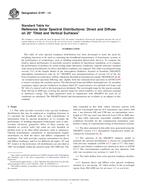
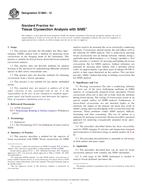 ASTM E1880-12
ASTM E1880-12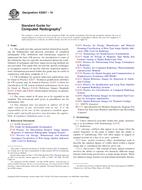 ASTM E2007-10
ASTM E2007-10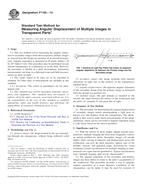 ASTM F1165-10
ASTM F1165-10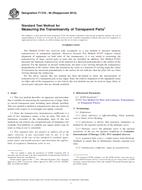 ASTM F1316-90(2013)..
ASTM F1316-90(2013)..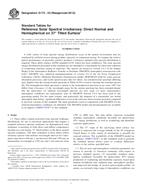 ASTM G173-03(2012)..
ASTM G173-03(2012)..
 Cookies
Cookies
